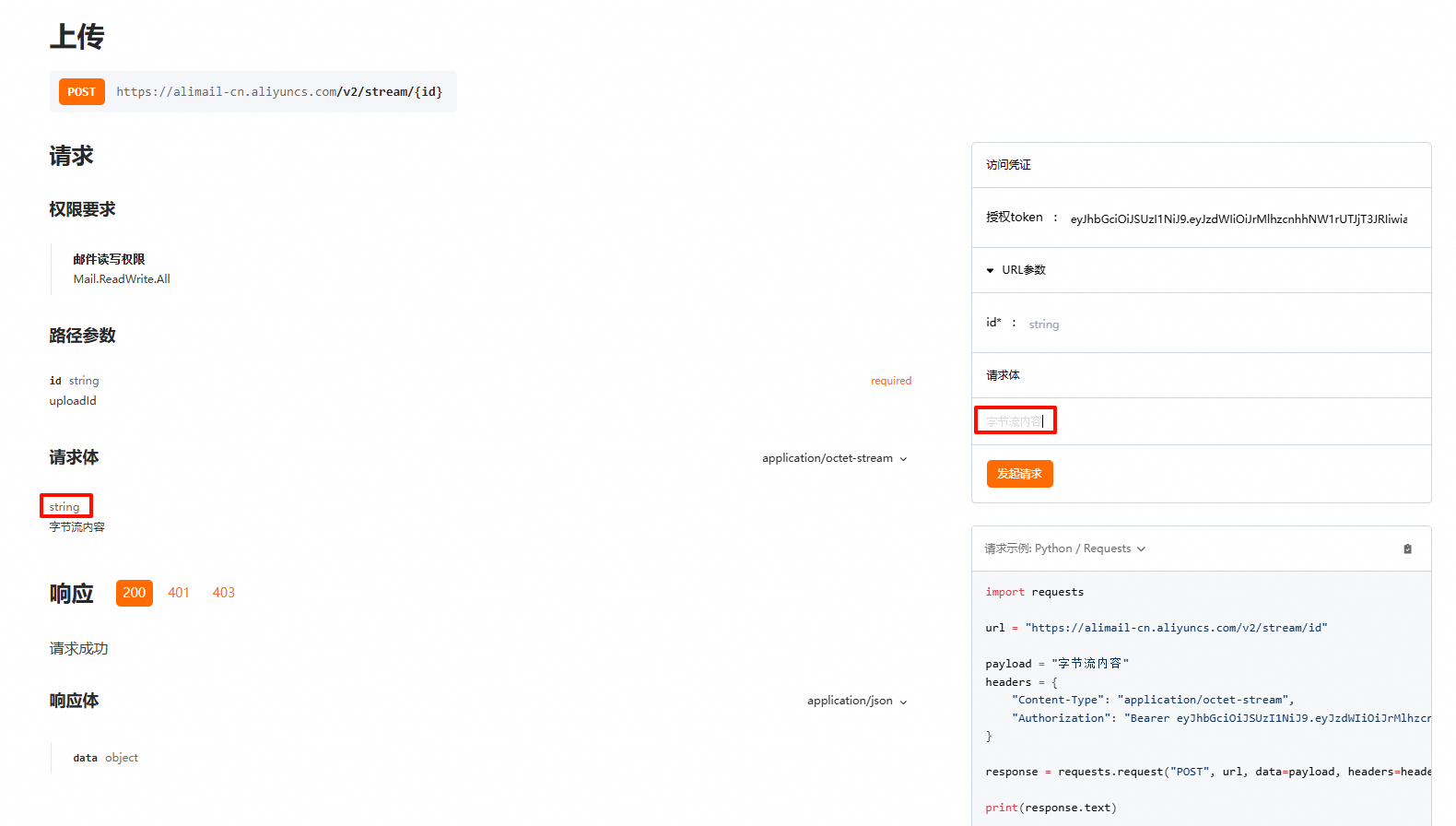本文介绍如何创建草稿并上传附件。
调用“创建草稿”接口,从返回值中获取id,也就是草稿ID;
草稿ID传入“创建上传会话(附件)”接口,截取出uploadUrl中的session值;
session值传入“上传文件流”接口,上传文件流,前往网页版邮箱的草稿箱,检查附件是否已上传完成。
相关接口
基本流程

Python示例代码
重要
风险提示:下述代码在Python 3.11.9进行的测试,用于生产环境之前请务必先做好测试。
# -*- coding: utf-8 -*-
import email
import os
import requests
# 导入获取访问令牌的函数,路径根据实际情况进行修改,或直接给access_token赋值用于测试
from api_demo.get_access_token import access_token
def create_draft(email_account, payload):
"""
接口名称:创建草稿
文档:https://mailhelp.aliyun.com/openapi/index.html#/operations/alimailpb_alimail_mailagent_open_MailService_CreateMessage
参数:
email (str): 用户邮箱地址
payload (dict): 邮件内容的JSON格式数据
返回:
str:: 创建的邮件草稿的ID
"""
# 构造请求URL
url = f"https://alimail-cn.aliyuncs.com/v2/users/{email_account}/messages"
# 构造请求头,包括内容类型和授权令牌
headers = {'Content-Type': 'application/json', 'Authorization': 'bearer ' + access_token}
# 发送POST请求,创建邮件草稿
response = requests.request("POST", url, json=payload, headers=headers)
# 打印请求和响应的详细信息
print('##########################################################################')
print('请求参数:', payload)
print('返回参数:', response.status_code, response.text)
print('##########################################################################')
# 返回邮件草稿的ID
return response.json()["message"]["id"]
def create_upload_session(email_account, v_id, file_name):
"""
创建上传会话(附件),为草稿邮件添加一个附件
文档:https://mailhelp.aliyun.com/openapi/index.html#/operations/alimailpb_alimail_mailagent_open_MailService_CreateAttachmentUploadSession
"""
url = f"https://alimail-cn.aliyuncs.com/v2/users/{email_account}/messages/{v_id}/attachments/createUploadSession"
payload = {"attachment": {
"name": file_name,
"contentId": "string",
"isInline": True,
"extHeaders": {
"property1": "string",
"property2": "string"
}
}}
headers = {'Content-Type': 'application/json', 'Authorization': 'bearer ' + access_token}
response = requests.request("POST", url, json=payload, headers=headers)
print(response.text)
json_payload = response.json()
print('##########################################################################')
print('请求参数:', payload)
print('返回参数:', response.status_code, response.text)
print('##########################################################################')
return json_payload['uploadUrl'].split('stream/')[1]
def upload_file(v_file, v_id):
"""
上传文件流
https://mailhelp.aliyun.com/openapi/index.html#/operations/alimailpb_stream_StreamService_DoUpload
:param v_file:
:param v_id:
:return:
"""
print('接口名称:', '上传文件流,upload_file')
url = f"https://alimail-cn.aliyuncs.com/v2/stream/{v_id}"
try:
with open(v_file, 'rb') as file:
payload = file.read()
except FileNotFoundError as e:
print(f"文件未找到: {e}")
return None
print(f'payload={type(payload)},{payload}') # <class 'bytes'>
headers = {
"Content-Type": "application/octet-stream",
"Authorization": 'Bearer ' + access_token
}
response = requests.request("POST", url, data=payload, headers=headers)
print('##########################################################################')
print('请求参数:', payload)
print('返回参数:', response.status_code, response.text)
print('##########################################################################')
# 定义邮箱地址和邮件内容的JSON格式数据
email_account = "test@example.com"
v_payload = {
"message": {
"internetMessageId": email.utils.make_msgid(),
"subject": "主题",
"summary": "摘要",
"priority": "PRY_NORMAL",
"isReadReceiptRequested": True,
"from": {
"email": "test@example.com",
"name": "test"
},
"toRecipients": [
{
"email": "test@example.com",
"name": "to"
}
],
"ccRecipients": [
{
"email": "test@example.com",
"name": "cc"
}
],
"bccRecipients": [
{
"email": "test@example.com",
"name": "bcc"
}
],
"replyTo": [
{
"email": "test@example.com",
"name": "replyTo"
}
],
"body": {
"bodyText": "bodyText",
"bodyHtml": "<h1>bodyHtml</h1>"
},
"internetMessageHeaders": {
"property1": "string",
"property2": "string"
},
"tags": ["string"]
}
}
# 调用函数创建邮件草稿并获取草稿ID
email_id = create_draft(email_account, v_payload)
print(f'email_id: {email_id}')
print('草稿创建完成')
# 本地附件
files = [r'C:\Users\PycharmProjects\aliyun\api_demo\123.txt',
r'C:\Users\PycharmProjects\aliyun\api_demo\234.txt']
for v_file in files:
file_name = os.path.basename(v_file)
print(f'附件名称:{file_name}')
# 创建上传会话(附件)
session_id = create_upload_session(email_account, email_id, file_name)
# print(f'session_id={session_id}')
print('创建上传会话(附件)完成')
# 文件流上传
upload_file(v_file, session_id)
print('上传文件流完成')
运行结果


常见问题
上传的附件是什么数据类型,如何在网页上测试?
在代码中实现时,上传的附件是字节流bytes类型。
try:
with open(v_file, 'rb') as file:
payload = file.read()
except FileNotFoundError as e:
print(f"文件未找到: {e}")
网页中测试txt附件时,直接输入文件内容的字符串即可。

该文章对您有帮助吗?